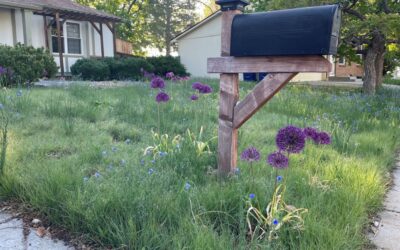Why native grass?
We need to landscape differently in Colorado. Maximizing our communities’ livability and climate resiliency starts with saving water—and native grasses are a low-water alternative to turf grass that mirrors Colorado’s natural grasslands.
Defining your goals
Save Money
Both low-water and low-maintenance, native grasses present a significant opportunity for landscape cost savings.
Most native and water-wise grasses require not only less frequent irrigation, but less frequent mowing and fertilization. To maximize your savings, choose a species known to thrive with low time-and-money investment.
Reduce Water Use
If your primary goal is to use less water in your landscape, review your irrigation system before converting grass to a different species.
How is your irrigation scheduled and managed? Could it be more efficient? Once you’ve addressed those questions, consider planting native grass—which requires 25-75% less water than turf grass (depending on the species).
The ultimate water savings will depend on the future versus current water use. To maximize savings, couple irrigation changes with native grass. Combining both efforts will lead to a healthy and beautiful water wise landscape.
More Resilient Grass
Are you dealing with a struggling or unhealthy lawn? It can be frustrating to water and care for a lawn that’s not doing well despite your best efforts.
Matching a native grass to your property’s site constraints and natural context—including the amount of sun exposure, the elevation, the soil texture, and the presence of pets—will ensure you have the most resilient grass type for your project.
Native grasses can survive irrigation failure, drought, and pauses in maintenance better than turf grasses. They also don’t suffer from winter kill as often since they’re adapted to Colorado’s weather extremes and dry conditions. Resiliency is their super power.
Before you switch to native grass, fix any underlying irrigation problems, assess the site’s limiting factors, and decide what type of maintenance is sustainable.
Maximize Environmental Benefits
If you’re focused on the environment, pay mind to grass species selection, functional landscape design, and maintenance practices that support wildlife lifecycles.
To maximize the benefits of your landscape for insects, birds, and wildlife, choose a mixture of grasses native to your specific area—these will provide the most valuable habitats and food sources.
Ready to plan your project?
While there is no overnight solution for sustainable landscaping, native grasses are one of the best places to start—and we’re here to help you along the way.
Initiate
Choose
Plan
Schedule
Install
Maintain
Explore Past Projects
See how fellow Coloradans—homeowners, HOAs, businesses, and municipalities—are implementing native grasses in their sustainable landscapes.
Wasson Park, Colorado Springs
Learn how Colorado Springs City Parks converted seven acres of Kentucky bluegrass to a native grass mixture with the support of Colorado Springs Utilities. Restoring native grasses in low-use peripheral areas of the park helped reduce water use, lower maintenance costs, and improve the park’s appearance and long-term sustainability.
Aurora Front Lawn Replacement
Read about replacing a turf grass front lawn with a buffalo grass, blue grama, sideoats grama, and wildflower mixture.
Pelican Ridge HOA, Fort Collins
Discover how this homeowners assocation replaced their turf grass with a buffalo grass and blue grama mixture for significant water and maintenance savings.
Upcoming Events
9:00 Am
May 21 2025
Planting Methods for Non-Irrigated Sites
Don Hijar, Owner, Pawnee Buttes Seed and Casey Davenhill, Executive Director, Watershed Assembly
Establishing native grasses without irrigation can be challenging in Colorado. We’ll explore the best practices for native grass seeding and establishment on non-irrigated sites. We’ll delve into lessons learned from the revegetation of thousands of acres of dryland wheat using native grasses and discuss how these practices can be adapted to urban and suburban environments.
9:00 Am
JUNE 11 2025
DENVER WATER ADMIN BUIlding native grass conversion (Virtual Event)
Austin Krcmarik, Water Efficiency Lead and Katie Fletcher, Sustainability Program Analyst, Denver Water
Learn about the native grass landscape at Denver Water’s administration building, along with its innovative onsite wastewater treatment system. Austin will provide an in-depth look at the project’s background and key details, while Katie will share insights into landscape management practices and the valuable lessons learned throughout the process.
Get our updates
Stay in the loop on what we’re learning about native grasses and best practices for sustainable landscaping in Colorado.
About us
The Native Grass Working Group is a team of dedicated, cross-industry leaders focused on identifying and educating about low-water, sustainable native grass alternatives for business, municipal, and residential landscapes.


